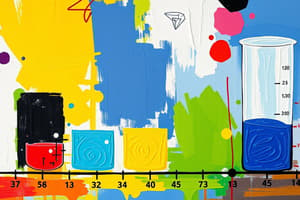Podcast
Questions and Answers
What is the purpose of pH indicators in chemistry?
What is the purpose of pH indicators in chemistry?
- To change color randomly
- To increase the acidity of a solution
- To help understand the acidity or basicity of a substance visually (correct)
- To measure the volume of a substance
In extremely alkaline conditions, what color does red cabbage juice turn?
In extremely alkaline conditions, what color does red cabbage juice turn?
- Red
- Blue (correct)
- Yellow
- Green
What does the pH scale measure?
What does the pH scale measure?
- Temperature of a substance
- Volume of a substance
- Acidity or alkalinity of a substance (correct)
- Pressure of a substance
Why is it important to understand acids and bases?
Why is it important to understand acids and bases?
What does neutralization allow us to do with acids and bases?
What does neutralization allow us to do with acids and bases?
What is the defining characteristic of neutral solutions?
What is the defining characteristic of neutral solutions?
Which of the following is an example of a basic solution?
Which of the following is an example of a basic solution?
What happens when a basic solution comes into contact with an acid?
What happens when a basic solution comes into contact with an acid?
Why do basic solutions leave a residue behind?
Why do basic solutions leave a residue behind?
How do chemists distinguish between different types of bases?
How do chemists distinguish between different types of bases?
Flashcards are hidden until you start studying
Study Notes
Overview of the pH Scale
The pH scale is used to measure how acidic or alkaline a substance is. It's based on a logarithmic scale from 0 to 14. A number closer to zero means more acidic, while numbers closer to 14 indicate higher alkalinity. Here we will discuss some key aspects related to acids, bases, neutralization, and pH indicators.
Acidic Substances
An acid has a sour taste and can react with metals to produce hydrogen gas and salts. Some common acids include vinegar, citrus fruits like lemons, and tomatoes. Acids tend to have lower pH values because they contain free protons — positively charged particles. These protons make water molecules around them less stable, which lowers the overall pH value of any solution containing an acid.
Bases
A base has a bitter, soapy taste and reacts with acids by producing hydroxide ions and salts. Common household bases include baking soda, ammonia, lye, soap, and toothpaste. Unlike acids, these chemicals usually cause the concentration of hydrogen atoms to decrease in water solutions, resulting in higher pH levels.
Neutralization Reaction
When an equal amount of both acid and base are mixed together, they form a neutral salt. This process, known as neutralization, results in a new chemical compound called a neutral salt. It also forms water; if there was extra water before it merged into one liquid - after mixing the acid and base, this liquid would become evenly distributed among all parts of the mixture.
pH Indicators
These are compounds that change color when exposed to different levels of acidity or basicity. They act as visual guides to help us understand what's going on in our chemical reactions better. For instance, red cabbage juice turns red in very acidic conditions and blue under extremely alkaline ones—in between those extremes, its color changes gradually according to where you put it along the scale. This helps people determine whether something is too acidic or too alkaline without having to do much measuring themselves.
In summary, the pH scale measures how acidic or alkaline a substance is. Understanding acids and bases can give insight into their characteristics, while neutralization allows us to mix them safely. Finally, pH indicators offer a convenient way to assess the degree of acidity or alkalinity of various substances easily.
Studying That Suits You
Use AI to generate personalized quizzes and flashcards to suit your learning preferences.




